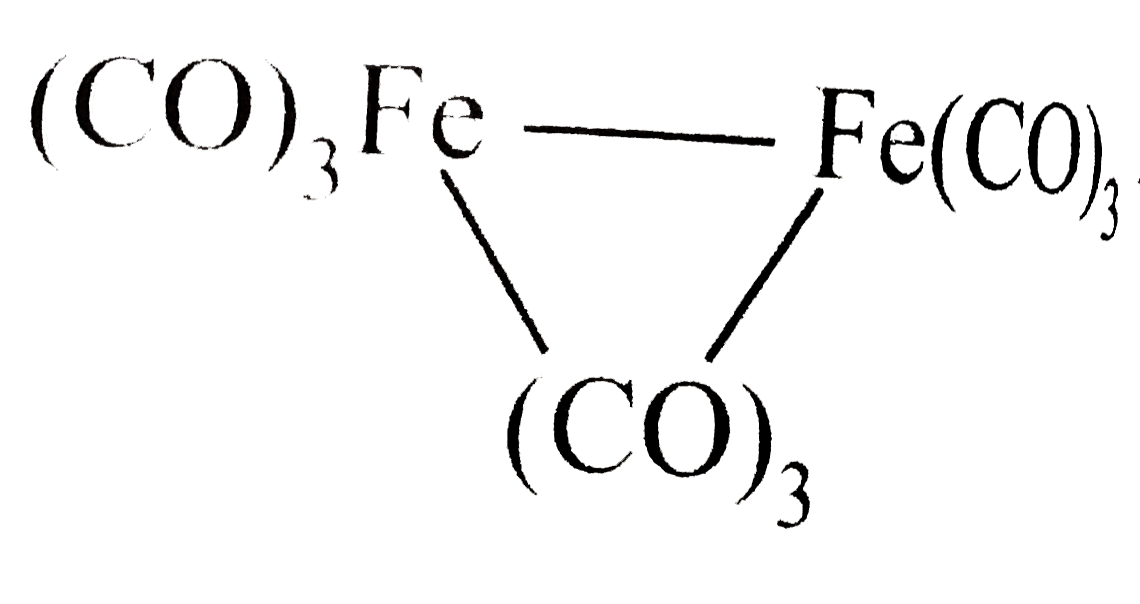The EAN of iron in [Fe(CN)6]3− is
26
35
38
29
To find the Effective Atomic Number (EAN) of iron in the complex ion (Fe(CN)6)3−, we can follow these steps:
Step 1: Determine the oxidation state of iron (Fe).
The complex ion (Fe(CN)6)3− has a charge of -3. The cyanide ion (CN) is a monodentate ligand with a charge of -1. Since there are 6 cyanide ions, the total negative charge contributed by the ligands is:
Charge from CN=−1×6=−6
Let the oxidation state of iron be x. The overall charge of the complex can be expressed as:
x+(−6)=−3
Solving for x:
x−6=−3⟹x=−3+6⟹x=+3
So, the oxidation state of iron in this complex is +3.
Step 2: Write the electron configuration of Fe in the +3 oxidation state.
Iron (Fe) has an atomic number of 26. The electron configuration of neutral iron is:
Fe: (Ar)3d64s2
When iron loses 3 electrons to form Fe3+, it loses the two 4s electrons and one 3d electron:
Fe3+:(Ar)3d5
Step 3: Calculate the total number of electrons available with iron.
The total number of electrons in Fe3+ is:
26−3=23
Step 4: Calculate the contribution from the ligands.
Each cyanide ligand (CN) donates a pair of electrons. Since there are 6 cyanide ligands, the total contribution from the ligands is:
6 ligands×2 electrons/ligand=12 electrons
Step 5: Calculate the Effective Atomic Number (EAN).
The EAN is calculated by adding the number of electrons from the metal ion and the electrons donated by the ligands:
EAN=Electrons from Fe3++Electrons from ligands
EAN=23+12=35
Thus, the EAN of iron in (Fe(CN)6)3− is 35.
Final Answer:
The EAN of iron in (Fe(CN)6)3− is 35.
---
The complex ion (Fe(CN)6)3− has a charge of -3. The cyanide ion (CN) is a monodentate ligand with a charge of -1. Since there are 6 cyanide ions, the total negative charge contributed by the ligands is:
Iron (Fe) has an atomic number of 26. The electron configuration of neutral iron is:
The total number of electrons in Fe3+ is:
Each cyanide ligand (CN) donates a pair of electrons. Since there are 6 cyanide ligands, the total contribution from the ligands is:
The EAN is calculated by adding the number of electrons from the metal ion and the electrons donated by the ligands:
EAN=23+12=35
The EAN of iron in (Fe(CN)6)3− is 35.
Topper's Solved these Questions
- ALCOHOLS, PHENOLS AND ETHERSBook:AAKASH INSTITUTE ENGLISHChapter: ALCOHOLS, PHENOLS AND ETHERSExercise:Try yourself
Explore 5 Videos
- ALCOHOLS, PHENOLS AND ETHERSBook:AAKASH INSTITUTE ENGLISHChapter: ALCOHOLS, PHENOLS AND ETHERSExercise:Exercise
Explore 40 Videos
- ALCOHOLS, PHENOLS AND ETHERS Book:AAKASH INSTITUTE ENGLISHChapter:ALCOHOLS, PHENOLS AND ETHERS Exercise:Try Yourself
Explore 5 Videos
Similar Questions
Knowledge Check
The hybridization of iron atom in [Fe(CN)6]3− complex is
Asp3Bd2sp3Csp3d2Ddsp2O.N. (Oxidation Number) of Fe in K4[Fe(CN)6] is
A+2B+3C+4D+6
The EAN of Fe atom in
 .
.
View SolutionWith Co2+ ions [Fe(CN)6]3− gives a ……..ppt of Co3[Fe(CN)6]
View SolutionDetermine the oxidation number (O.N) of Fe in [Fe(CN)6]4−
View SolutionThe complex ion [Fe(CN)6]4− contains:
View SolutionThe spin magnetic moment of iron in K3[Fe(CN)6]
View SolutionAssertion : The blue precipitate formed by the action of K4[Fe(CN)6]onFe3+ and by that of K2[Fe(CN)6] on Fe2+ have the same composition
Reasion : [Fe(CN)6]3− oxides Fe2+ to Fe3− and itself gets reduced to [Fe(CN)6]4−.
View Solution